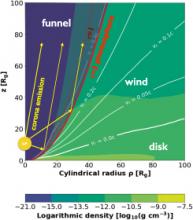
Abstract
X-ray reverberation has proven to be a powerful tool capable of probing the innermost region of accretion disks around compact objects. Current theoretical effort generally assumes that the disk is geometrically thin, optically thick, and orbiting with Keplerian speed. Thus, these models cannot be applied to systems where super-Eddington accretion happens because the thin disk approximation fails in this accretion regime. Furthermore, state-of-the-art numerical simulations show that optically thick winds are launched from the super-Eddington accretion disks, thereby changing the reflection geometry significantly from the thin disk picture. We carry out theoretical investigations on this topic by focusing on the Fe Kα fluorescent lines produced from super-Eddington disks, and show that their line profiles are shaped by the funnel geometry and wind acceleration. We also systematically compare the Fe line profiles from super-Eddington thick disks to those from thin disks, and find that the former are substantially more blueshifted and symmetric in shape. These results are consistent with the observed Fe Kα line from the jetted tidal disruption event, Swift J1644, in which a transient super-Eddington accretion disk was formed out of stellar debris. Therefore, careful analysis of the Fe Kα line profile can be used to identify systems undergoing super-Eddington accretion.